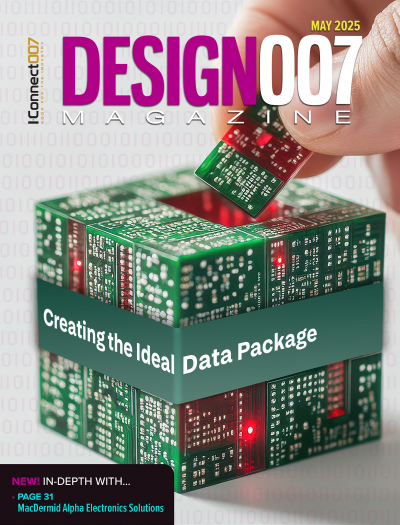-

- News
- Books
Featured Books
- design007 Magazine
Latest Issues
Current Issue
Showing Some Constraint
A strong design constraint strategy carefully balances a wide range of electrical and manufacturing trade-offs. This month, we explore the key requirements, common challenges, and best practices behind building an effective constraint strategy.

All About That Route
Most designers favor manual routing, but today's interactive autorouters may be changing designers' minds by allowing users more direct control. In this issue, our expert contributors discuss a variety of manual and autorouting strategies.

Creating the Ideal Data Package
Why is it so difficult to create the ideal data package? Many of these simple errors can be alleviated by paying attention to detail—and knowing what issues to look out for. So, this month, our experts weigh in on the best practices for creating the ideal design data package for your design.
- Articles
- Columns
- Links
- Media kit
||| MENU - design007 Magazine
Component Selection for Easier Design and Manufacture of Electronics
December 17, 2014 | Joe Fjelstad, Verdant ElectronicsEstimated reading time: 1 minute
“Simplify, simplify, simplify.”
—Henry David Thoreau
Thoreau penned his simple lifestyle mantra more than 150 years ago and it still as valid today as it was when he first captured and recorded his thoughts on paper. He was not the first to extoll the importance of simplicity, but he said it in a memorable way.
Achieving simplicity has been deemed a worthy objective by many philosophers over centuries, and people often profess to seek simplicity in their lives. In the world of high tech, simplicity is arguably one of the foundational objectives of most of the technologies that surround us today. Certainly this is true in terms of how product designers are trying to create interfaces that allow even the most nontechnical users to get what they need from electronic products with a minimum of hassle.
However, that interface simplicity is undergirded by a massively complex electromechanical substructure of circuits, sensors and components. Pop open any high-end electronic device and you will be met by an impressive mass of densely packed components and circuits. Presently, those components are available in a wide array of formats, with a number of different lead shapes and forms along with the device’s mechanical outline. Presently, there are J-leads, I-leads, gull-wing leads, posts, balls and no leads at all. Mechanical outlines are generally square and rectangular, but the bodies can have a wide range of dimensions in X, Y and Z. While area array technology has helped to make things smaller, it has also upped the complexity factor from a design perspective by mixing grids and land shapes and sizes.
Why so many options? It is because there is not, nor has there ever been, a truly coherent approach to the process of selecting package structures for ICs or any other components for that matter. Yes, a roadmap for electronic component lead pitch was introduced with the advent of SMT, and that roadmap said that every next-generation lead pitch should be 80% of the size of the previous generation lead pitch.
Read the full article here.
Editor's Note: This article originally appeared in the November 2014 issue of The PCB Design Magazine.
Suggested Items
Microchip Enters into Partnership Agreement with Delta Electronics on Silicon Carbide Solutions
07/18/2025 | Globe NewswireThe growth of artificial intelligence (AI) and the electrification of everything are driving an ever-increasing demand for higher levels of power efficiency and reliability.
ESD Alliance Reports Electronic System Design Industry Posts $5.1 Billion in Revenue in Q1 2025
07/16/2025 | SEMIElectronic System Design (ESD) industry revenue increased 12.8% to $5,098.3 million in the first quarter of 2025 from the $4,521.6 million registered in the first quarter of 2024, the ESD Alliance, a SEMI Technology Community, announced in its latest Electronic Design Market Data (EDMD) report.
Beyond Design: Refining Design Constraints
07/17/2025 | Barry Olney -- Column: Beyond DesignBefore starting any project, it is crucial to develop a thorough plan that encompasses all essential requirements. This ensures that the final product not only aligns with the design concept but is also manufacturable, reliable, and meets performance expectations. High-speed PCB design requires us to not only push technological boundaries but also consider various factors related to higher frequencies, faster transition times, and increased bandwidths during the design process.
Prague PEDC: Call for Abstracts Deadline July 31
07/16/2025 | Pan-European Electronics Design Conference (PEDC)The second Pan-European Electronics Design Conference (PEDC) will take place Jan. 21-22, 2026, in Prague, Czech Republic. The call for abstracts deadline is July 31. Organized jointly by the German Electronics Design and Manufacturing Association (FED) and the Global Electronics Association PEDC serves as a European platform for knowledge exchange, networking, and innovation in electronics design and development.
The Pulse: Design Constraints for the Next Generation
07/17/2025 | Martyn Gaudion -- Column: The PulseIn Europe, where engineering careers were once seen as unpopular and lacking street credibility, we have been witnessing a turnaround in the past few years. The industry is now welcoming a new cohort of designers and engineers as people are showing a newfound interest in the profession.


